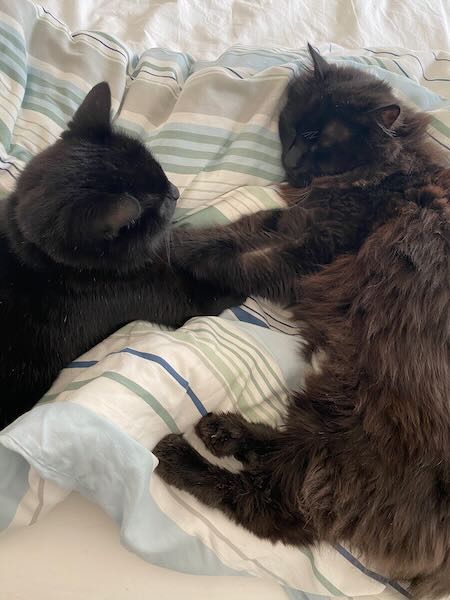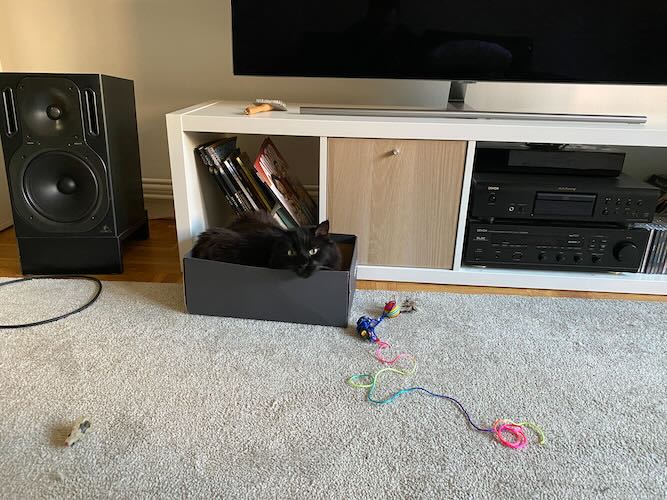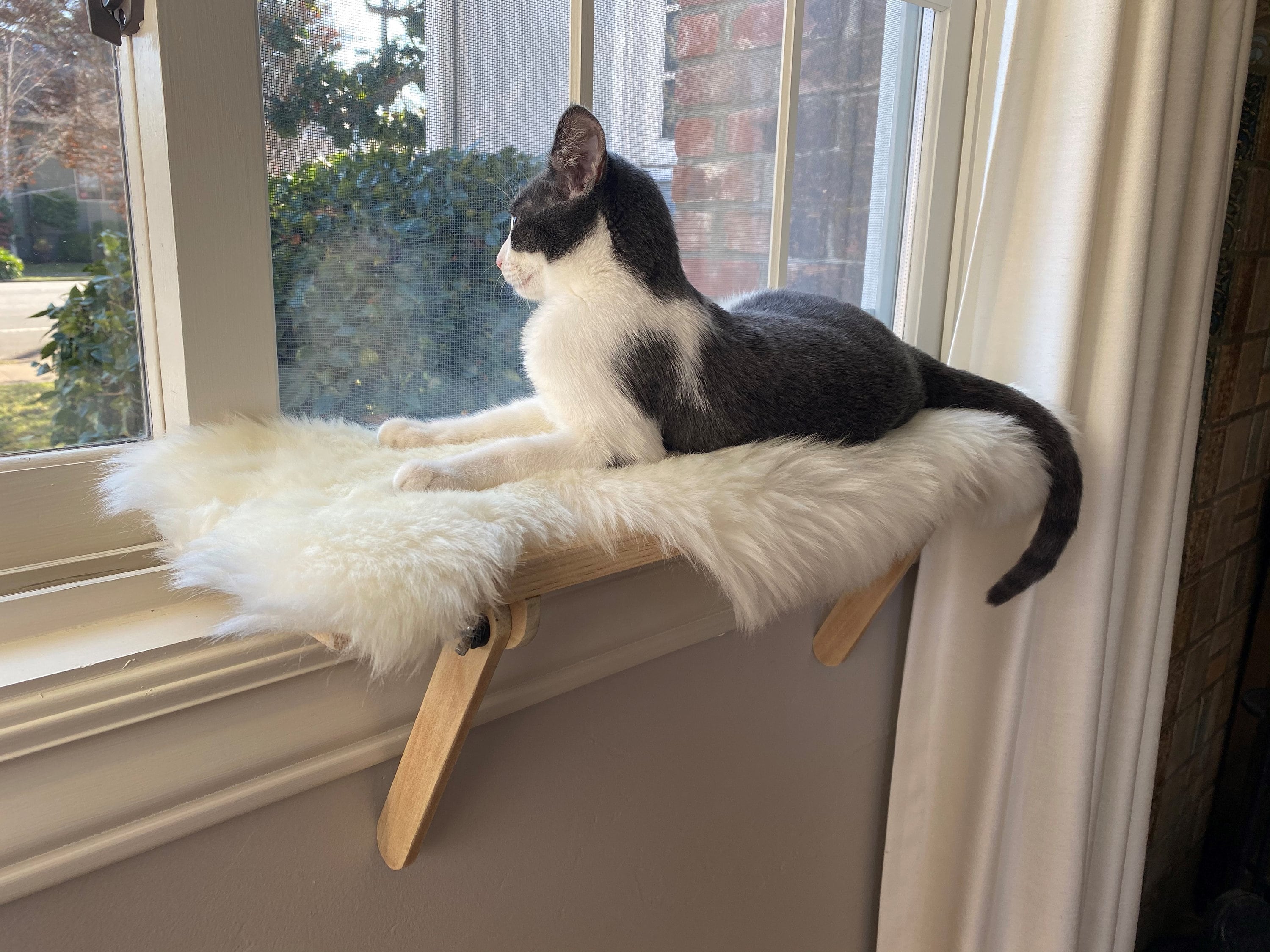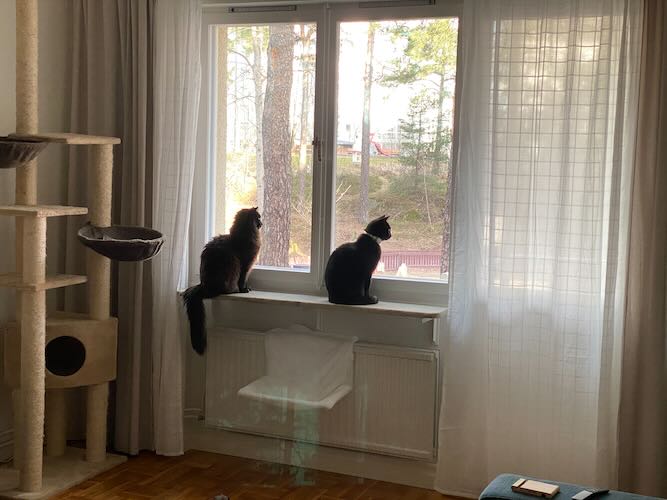Cat Care Tips
Tips For Adopting and Taking Care of Cats
After years of living with, rescuing, and learning about cats, here’s a brief summary of what I know about caring for cats and living in harmony with them.
First needs
I’ll try to list what cats will need upon arrival, in order of priority.
Calm ‘base’
Cats are psychologically fragile animals. They can easily become overwhelmed and depressed. Changes in their environment, noise, any change in their routine puts them under great stress.
They need a safe / quiet place where they won’t be disturbed. This is important in the first few days and throughout their lives.
They may hide under the bed or behind the couch for this reason.
This can be a cardboard box on the side with a blanket or pillow underneath. The top should be covered to help them feel safe.
Other people, petting
It is best to not disturb the cat for the first day, esp. for first couple hours. They may be quite scared and confused. Leaving them in their previously arranged ‘Base’ is a good idea. Guests, to much noise, many people showing attention is for them stressful.
Later on, petting should be done by first allowing the cat to smell your hand, by slowly approaching from the chin, basically surrendering yourself, letting the cat decide whether they want to be petted or not.
Cats like to be stroked around the head, usually not the belly or tail. As they grow, you may be able to pet their bellies as well, but some cats may never like it.
Petting can be overstimulating for a cat, and purring may follow a sudden slap, bite, or scratch. In cat’s world, this is usually not aggressive, but just communicating that it is enough. I recommend petting a little less than they want, and adjusting over time. When the trust has been built up over years, you can do whatever you want and the communication becomes meowing, rather than biting.
Toilet
Initially ‘base’ should be not far from the litter box, especially for kittens. You can put the cat on the litter box and leave him so he’ll go back to his base and know where the litter box is. Kittens may need a staircase (built with a book etc.) to get to the litter box.
Soon after, you may want to put the box away from the food source, perhaps to the bathroom.
Litter box material
Silica crystal and scented litter are not healthy for the cat or you. You wouldn’t want to inhale their dust. For kittens, I’d recommend “natural” litter for the first few months.
Switching to wood pellets and mesh box, is cleaner and requires much less work.
I use PeeWee:
Cats may resist new litter material. To help them, mix it with their previous litter, not a fresh one, so the new litter has some of their previous texture and smell.
Teaching your cat to use the toilet bowl
I have successfully taught my cat to use the toilet bowl in the past. But I was unaware of the problems involved:
- It can be a safety hazard, they can fall, the lid can close on them.
- Not natural for the cats, making urination stressful.
- Their litter box, and its smell mark their territory. They’ll feel stressed without it.
- As they get older, it becomes dangerous for them, because they may have difficulty balancing on the edge of the toilet bowl.
- You’ll have to keep the lid open.
Food and water
Food
- Dry food (kibble) is suspected to cause cancer and unirary tract infections in the long term. However, it is convenient and trains their jaws and teeth. I recommend giving them less and good quality.
- Wet food is much better.
- A clean bowl is important. A bowl is not needed for wet food. I use regular (small) flat plates that I put in the dishwasher afterwards.
- Feeding should be in the same place, 2-3 times a day for adult cats, much more for kittens, depending on their age.
- The feeding place should be away from their litter box, not in the bathroom.
Water
Cats tend to not drink enough and develop kidney and urinary problems over the years. I recommend:
- Glass water bowls that don’t cause smell.
- Changing the water daily,
- Have more than one bowl in different places.
Scratching post, cat tree
Important need for a cat. Having it ready before the cat arrives will also save you from furniture damage.
Many scratching posts on the market are too small for cats to stretch their bodies and get a satisfying scratch.
I use this one, which can be attached to the side of a cabinet:
You can make a climbing surface by fixing a couple of them, which can be a good training and playing place as well.
Second cat
Adopting a second cat makes everything easier.
Two cats will:
- Play with each other, release their energy, not annoy you much.
- Teach each other that biting and scratching hurts.
- Be happier overall and do fun things together for you to watch.

Entertaining
Playing
Unless you have a second cat, regular play with a cat is a necessity.The most effective toy to play with is probably a “cat wand”:

Wearing a sock like a glove and playing “wrestling” is also a good one.
Box
My cats have two boxes, one shoe box, and a larger cardboard box.

Observing
Something like this, or a cat tree by the window will keep them entertained:

Or a cat tree, like mine:

Climbing on a tree is great exercise for them
Cat entertainment videos may also work:
Letting them out
Prevent them from getting lost
I let my cats out regularly, they have been lost twice in 6 years.
They tend to go inside strange places, where they get trapped. The solution is to use a tracking device attached to their collar. I use a radio type, instead of GPS. It has a short range, but it is small and works indoors. I have had mediocre results with Airtags.

Preventing hunting
They kill mice and small birds. This is not only is sad for the animals, but also a health risk. Salmonella from sparrows, for example, can spread to both your cat and you.
The solution is to put a bell on their collar:

Care
Brushing
Daily brushing is a necessity for their health. Longhaired cats need it more. I get the best results with a non-rounded wire type brush.
Claw trimming
Trimming the claws doesn’t always stop the cat from scratching the furniture.
Excess length is a problem for them and for you. So I trim them monthly.
It is important to not cut too deep:

Here is a good guide: https://cat-world.com/trim-cats-claws-including-photos/
Hair trimming
- I don’t recommend taking a cat to the groomer or having a cat’s hair trimmed.
- Longhaired cats need a “sanitary trim”.
Preventing unwanted behavior
Punishment, including water spraying, doesn’t work with cats. They tend to associate the punishment with you rather than their behavior.
Consistent behavior on the part of the owner is important.
Furniture damage
The best way to reduce damage is to have scratching posts around the house before the cats arrive.
After the cat has developed a habit of scratching furniture, you can try fixing the furniture with double-sided tape, applying watered-down lemon to double-sided tape, etc. Although I have no first-hand experience with this.
I choose to see the damage they cause as their trace, their memory. For me, they’ll have sentimental value after my cats are gone.
Biting and scratching
If you have more than one cat, they’ll teach each other that biting and scratching hurts.
If you have one cat, you can “bite” her ears a little with your fingernails. This should be just hard enough to mimic how it would feel if another cat were to bite it. It may take a year for kittens to learn not to bite or scratch. They also need a chewing stick to exercise their teeth as they grow.
More
I plan to write about the following topics:
- Other unwanted behaviors.
- Medication, vet. visits.
- More resources.

